Kel’el Ware Approaches Life-Changing NBA Dreams After Success at Indiana

BLOOMINGTON, Ind. — Kel’el Ware’s high school team was five days away from playing for the Arkansas state championship when his head coach set him down for a talk.
North Little Rock had lost just two games all season. Ware was having a monster year as a junior, averaging 16.2 points, 9.1 rebounds and 4.1 blocks a game. Head coach Johnny Rice knew he connected best with Ware in one-on-one conversations, and he told him if he kept playing with that motor they could win the Arkansas state championship, he would be the MVP — and it could change his life.
“Kel’el, you can make generational money,” Rice recalls telling his star player.
‘‘What do you mean, generational?’’ Ware asked.
“You can make money playing basketball with what God has given you if you just apply yourself 100 percent,” Rice told him. “Then you’ll make money for your family, your brothers and sisters, mom and dad, everybody, your kids down the road. That’s money that could touch all of them.”
North Little Rock defeated Little Rock Central 65-55 in the Class 6A state title game. Ware finished with 19 points, eight rebounds and three steals on his way to winning MVP honors.
“I kind of saw something with him where he had the confidence like, ‘Man, I really can be different and elite,’” Rice said. “It put him on a different level, mentally, and I think that’s when things clicked with him more than ever.”
This year, things have clicked for Ware at Indiana. The 7-footer capped off his sophomore regular season Sunday against Michigan State with a dominant performance: A career-high 28 points, 11 rebounds, two blocks and two assists. He’ll soon decide whether he is prepared now to go after that generational money in the NBA or should return to Bloomington for another year to better ensure he secures that life-changing financial security he and Rice talked about just three years ago.
An underwhelming freshman season at Oregon put his future in doubt, but Ware has reinvigorated his NBA draft stock in one season at Indiana. If the 7-footer’s improvement is a sign of things to come, there’s no telling what he can accomplish.
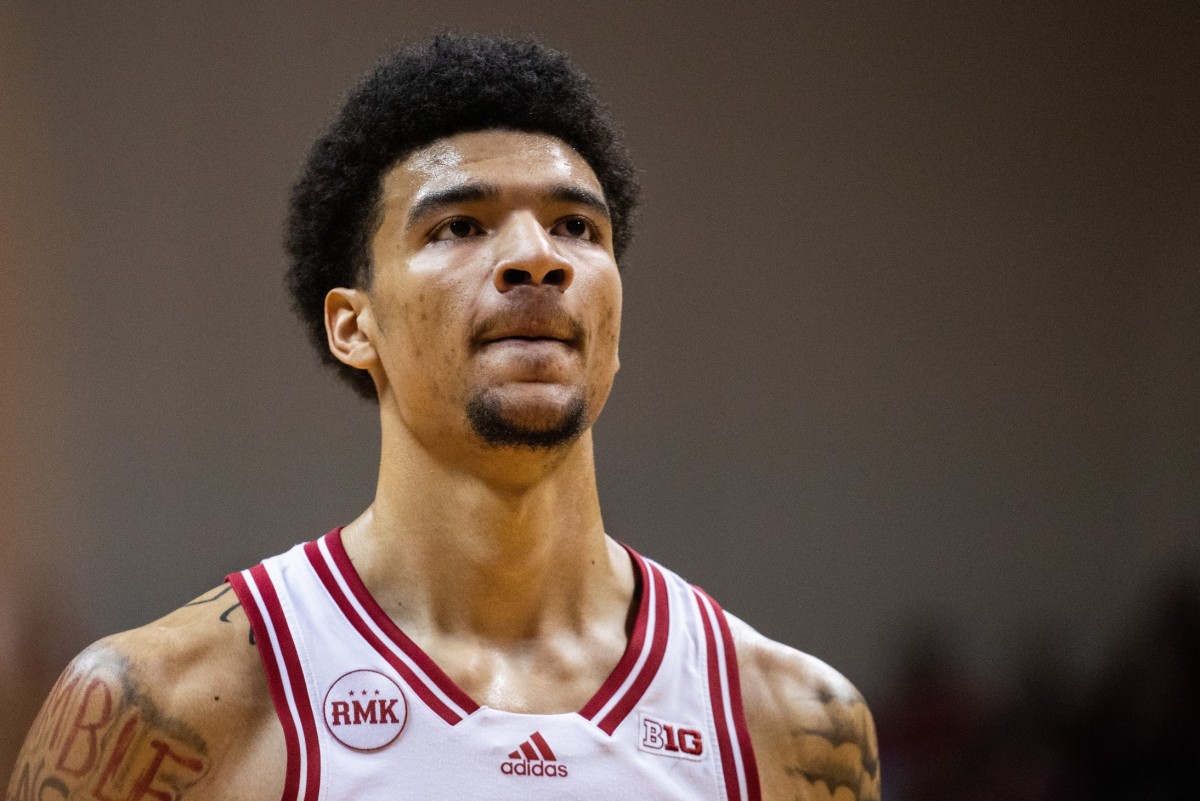
High school development
At North Little Rock High School, Rice saw it early – the athleticism, the unreal length, and the uncanny shot-blocking ability. Kel’el Ware was 14. Ware, about 6-foot-9 at the time according to Rice, started on the freshman team. Rice called him up to the varsity at the end of the freshman team’s season, which left one regular season game and the state tournament.
“He never showed any emotion about much of nothing when he was very young as a ninth grader,” Rice recalls. “I know I talked to him and his mom about it — he seemed excited and all that — but he wasn’t a guy, especially in the ninth or 10th grade, that showed a lot of emotion.”
Rice played Ware sparingly as a freshman, and North Little Rock lost in the state quarterfinals. Heading into Ware’s sophomore year, Rice knew he was working with a rare talent who had great upside. But getting him to play to the best of his ability on a consistent basis was a challenge.
Ware was rail-thin in high school, and his development started with what Rice called “toughness drills.” The whole team participated, but Rice said it was geared toward Ware. This included two-on-one drills and “war rebounding” drills, which required players to get a certain amount of rebounds and defensive stops in order to complete the drill.
In practice, Ware was pounded and pushed with pads to build toughness and a stronger lower body. A strength trainer worked with the team. In games, Rice set rebounding goals for Ware, and they’d watch film postgame to count how many times he sprinted to the rim.
Ware averaged 12.7 points and 6.8 rebounds per game as a sophomore, but North Little Rock’s season ended in the state quarterfinals again. Still, Rice knew Ware had the potential to make basketball a career.
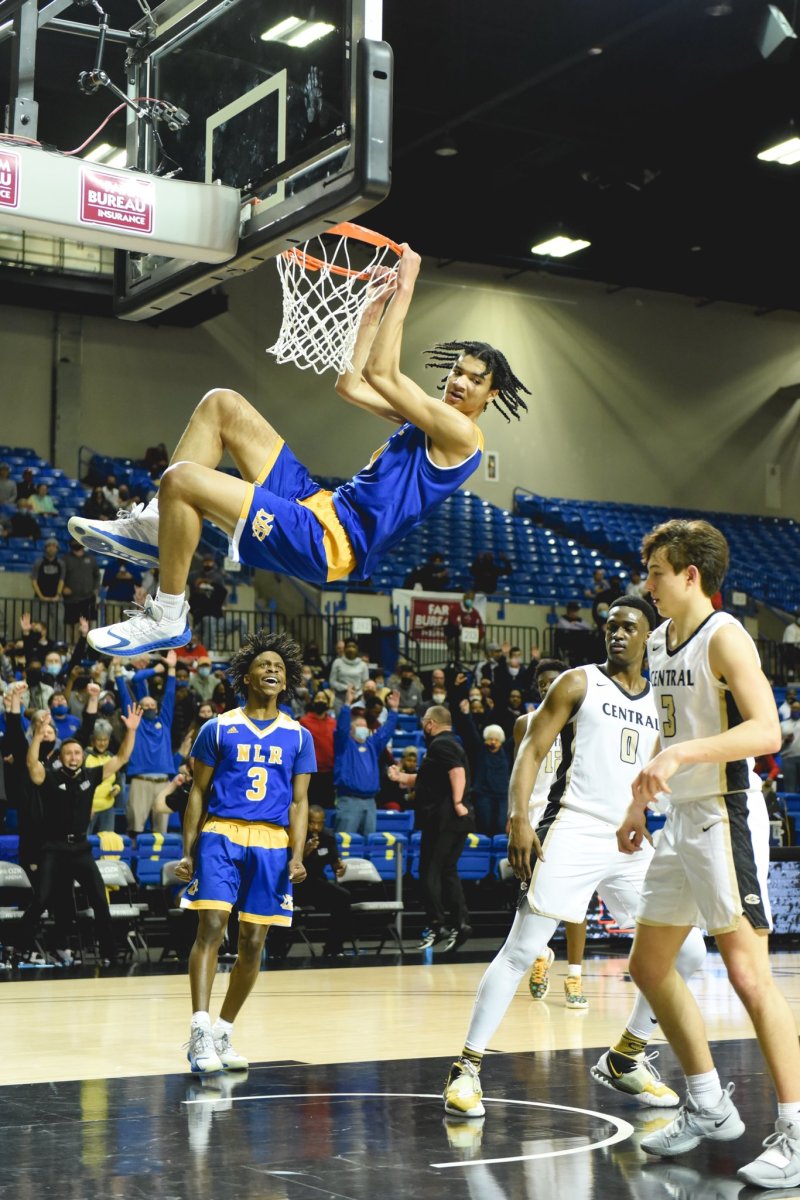
“We would talk to him and say, ‘The level you’re going to play at, they’re going to interview you, you’re going to have cameras and microphones stuck in your face,’ and he would kind of just grin,” Rice recalls. “I wouldn’t say that he was socially awkward, he was just really quiet.”
Working with Ware’s personality, Rice said he tried everything to see what would stick. Every player responds differently to coaching, and figuring out the way to get to Ware took time, whether that was patting him on the back with encouragement or being more verbal and punishing him for not playing hard.
“That’s not a fun thing to coach,” Rice said. “But with him being so young, it was something we worked on every day. We stayed on him about playing with a little more passion and it was a work in progress, but he did improve every single year.”
Following a state championship run as a junior, Ware averaged 20.3 points, 12.0 rebounds, and 5.7 blocks per game during his senior season. North Little Rock added current Charlotte Hornets guard Nick Smith Jr. that year, who was the No. 1-ranked player in the nation by 247 Sports. Ware was close behind at No. 7. They went undefeated in conference play en route to a second consecutive state championship. From Ware’s sophomore to senior season, North Little Rock went 70-10.
By the end of Ware’s junior season, Rice said getting him to play hard was no longer an issue. His confidence grew, and he played like it.
“He was just different in a more consistent way at that time,” Rice said. “Because you would see flashes all the time, but you wouldn’t see it consistently. It was like that light went off at the end of his junior year.”
Adversity out west
Ware’s high school success and potential as a 7-footer with a versatile skill set drew so much attention that he was a projected NBA lottery pick before his first game at Oregon. He started off well as a freshman, averaging 16 points and 8.3 rebounds against Connecticut, Michigan State and Villanova in the Phil Knight Invitational in November.
But the success was short-lived. Across the final 28 games of his freshman year, Ware scored double-digit points just four times. His minutes fell from the 20s and 30s in November and December to just 11.2 per game in his final 21. Oregon had veteran forwards and centers on the roster who eventually took his minutes.
Oregon coach Dana Altman explained at least twice during the season why Ware’s role decreased. After a 13-point, six-rebound performance in a win over Oregon State, Altmain paid Ware what sounded like a backhanded compliment, perhaps hoping to motivate his center.
“Kel’el showed a little bit more aggressiveness, a little bit more energy,” Altman said in December 2022. “There’s still a ton more there, but he at least acted like he wanted to be here tonight.”
Altman’s concerns about Ware surfaced again nearly a month later.
“We’ve had a lot of conversations,” Altman said in January 2023. “They haven’t gone as well and haven’t been as constructive as we want them to be. I was disappointed in his effort. I let him know that. He’s gonna have to make some adjustments or I’ve got to make some decisions. His time has been reduced. That doesn’t help us, because he is talented.
“He hasn’t blocked any shots lately. He hasn’t gotten any hands on balls,” Altman continued. “He’s not using that length. We’ve still got to try to put the best team out there that gives us the best chance. If he’s playing hard, that would help us. But if he’s not, that hurts us.”
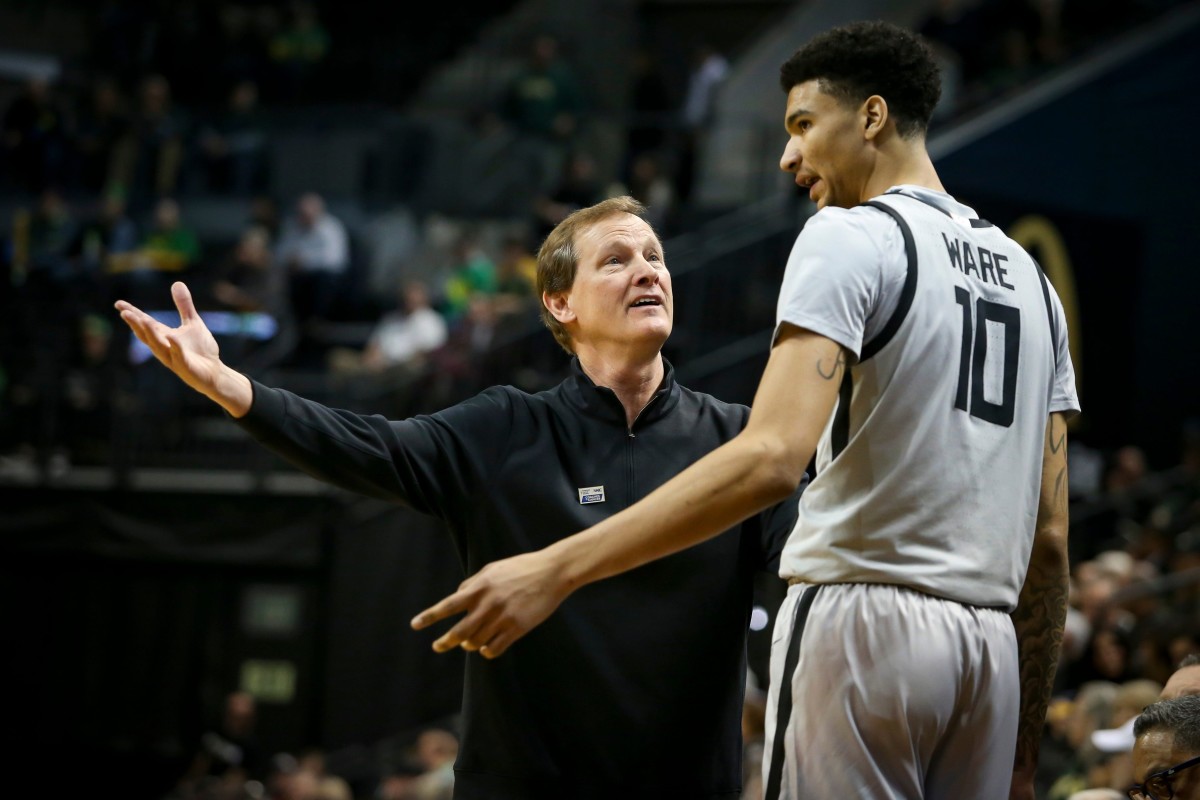
Ware finished the year averaging 6.6 points, 4.1 rebounds and 1.3 blocks per game, while shooting 45.7% from the field, 27.3% from the 3-point line and 71.2% on free throws.
Though Ware carried the five-star label to Oregon, NBA draft analyst Corey Tulaba of No Ceilings thinks his freshman season wasn’t shocking. He also had concerns about Ware’s motor and anticipated the adjustment to college against bigger and stronger defenders being difficult.
Despite an underwhelming season, Tulaba thinks Ware still would have been drafted because of his physical tools and athleticism. But the important factor to consider is whether he would have been drafted high enough to receive a guaranteed contract, which Tulaba questions.
Players can enter the draft, receive feedback and still return to college, but Ware made a decision early not to enter the draft. He realized he wasn’t strong enough for the NBA yet, and there were still aspects of his game that needed work.
Ultimately, Tulaba thought it was a good decision for Ware to return to college to improve his game and potentially be part of a draft class viewed as weaker overall, giving Ware a better chance to be drafted higher.
Last summer, he trained at Proactive Sports Performance in California, where fellow NBA hopefuls like Jalen Hood-Schifino, Jaime Jaquez, Jett Howard and others worked out.
A video produced by the Pac-12 Network showed Don MacLean, a former UCLA and NBA player, pushing Ware to become a more dominant force.
“You got him on you, the lightest guy in the workout, and you didn’t even act like – you got down here, but you didn’t even act like you wanted the f*****g ball, man,” MacLean said. “You gotta show him that you want the ball. They’re not going to just give it to you. Spread out, get big, turn and f*****g dunk on his head.”
While in the transfer portal, Ware knew there would be available minutes at center at Indiana, where he saw Woodson have success with Trayce Jackson-Davis, a consensus All-American and NBA draft pick.
“I know [Woodson is] going to get me to play hard,” Ware said. “That's what I'm looking for going into this season, just to prove everyone wrong. Some people say I don't have a motor, so I'm just ready to prove them wrong."
Woodson was aware of the criticism as well. He told Ware to focus on building a new life in Bloomington.
"When I recruited that young man,” Woodson said. “I told him, ‘You cannot go back and get what happened the year before. You can't. The word is out. They knocked you and said, hey, you're lazy, you don't work hard. And if you make a commitment to me, that's got to change.’
"I'm not always the easiest coach to play for, but I'm in your corner and I'm fair and I want what's best for you and my ballclub. And he made the commitment to me, and I'm going to push him to play at a higher level to help us win basketball games.”
Turning potential into production
A change of scenery alone wasn’t going to alleviate the concerns from his freshman year. That required hard work from Ware and hard coaching from Woodson. And change didn’t occur overnight.
Woodson recalls Ware went through the motions during his first practice with the Hoosiers. He went after the 7-footer, trying to motivate him to play at a high level.
“A lot of Coach Woodson screaming from the very beginning when I got him,” Woodson said. “I don't mean that in a bad way. I just tried to push him, along with our coaching staff. Because the first two or three weeks with him was a nightmare in terms of his energy and his get-up-and-go.”
When it was time for games, Ware’s sophomore season at Indiana started off strong. He had a combined 42 points on 18-for-22 shooting and 18 rebounds in his second and third games against Wright State and Army. It was a good start, even against weaker competition.
“I would say I'm more in a groove now with Coach Woodson giving me that role where he trusts me enough to just go make a play and attack the basket, score, even throw it out to my teammates and just play smart on the court,” Ware said after the Wright State win. “As long as I'm playing hard and just giving them that, then we should be good.”
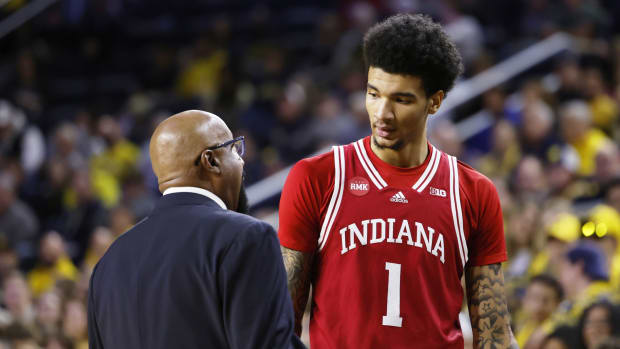
Adversity hit when Ware matched up against some of the top centers in college basketball during nonconference play. Facing UConn’s 7-foot-2 center Donovan Clingan, Ware got pushed around. He finished 2-for-10 from the floor, fading on shots rather than going up strong and shying away from the paint. He didn’t block a single shot in the 20-point loss, one of just four games all season where that’s happened.
Games against Auburn and Kansas — teams anchored by All-American candidates Johni Broome and Hunter Dickinson at center — showed Ware was a tier below the nation’s best centers yet again. The Hoosiers were blown out by Auburn, 104-76, despite leading 22-10 in the first eight minutes. Woodson said Auburn physically took Indiana out of everything it wanted to do.
Indiana later led Kansas for 35 minutes before crumbling down the stretch in a 75-71 loss. Dickinson scored two clutch baskets over Ware down the stretch. In those two games combined, Ware shot just 5-for-20 from the field, but held his own on the glass.
“I don't know if Ware was tired at that particular time,” Woodson said after the Kansas loss. “But he just didn't battle (Dickinson) like he did the first half and throughout the first half.”
Similar struggles continued in Big Ten play, most notably against Purdue’s soon-to-be two-time National Player of the Year Zach Edey. Ware got into early foul trouble, and he finished the first matchup with a season-low five points on 2-for-6 shooting.
The second rivalry game was a tick better for Ware, offensively, as he scored 11 points on 5-for-7 shooting with eight rebounds. But Edey finished with 26 points and 13 rebounds in a 20-point win.
These performances against elite college centers may give NBA teams reason for pause when considering drafting Ware early in the first round or offering a guaranteed contract. The physical nature of these games suggest another year of development under Woodson could be beneficial.
But these weaknesses have been offset by games when Ware answered questions about his motor and physicality and displayed a tantalizing skill set at 7-feet tall — soft touch around the rim, an unstoppable lob threat, timely shot-blocking and a 3-point shot opponents must respect.
Perhaps most importantly, Ware has played over a dozen games this season where his effort and toughness was far better than at any previous point in his career.
“It's the second effort,” Woodson said. “When we first got him, that didn't even exist in terms of him making second and third efforts to try to go get the basketball. A lot of it was he just hadn't been taught and pushed to do it. I mean, it's like night and day from the time we got him to where he is today in terms of going hard and understanding that you just can't take possessions off.”
In Ware’s first Big Ten game, facing constant double-teams and a physical Maryland defense that now ranks 11th nationally per KenPom, Ware proved he could win a gritty matchup. He scored 18 points and grabbed 14 rebounds, outplaying Maryland’s Julian Reese, one of the better big men in the conference.
For Woodson, it was a sign Ware had the fortitude needed to win Big Ten games.
“Well, he's been smacked around a little bit this early season,” Woodson said. “Hey, it's part of the game, man. You've got to get in the fight. I thought he did a great job in holding his own and demanding the ball and making plays when he got the ball.”
Ware helped the Hoosiers jump out to a 2-0 start in Big Ten play the next game, using his 7-foot-4 wingspan to bat down Michigan’s last-gasp entry pass just before the buzzer. Few players at the college level are physically capable of making that play.
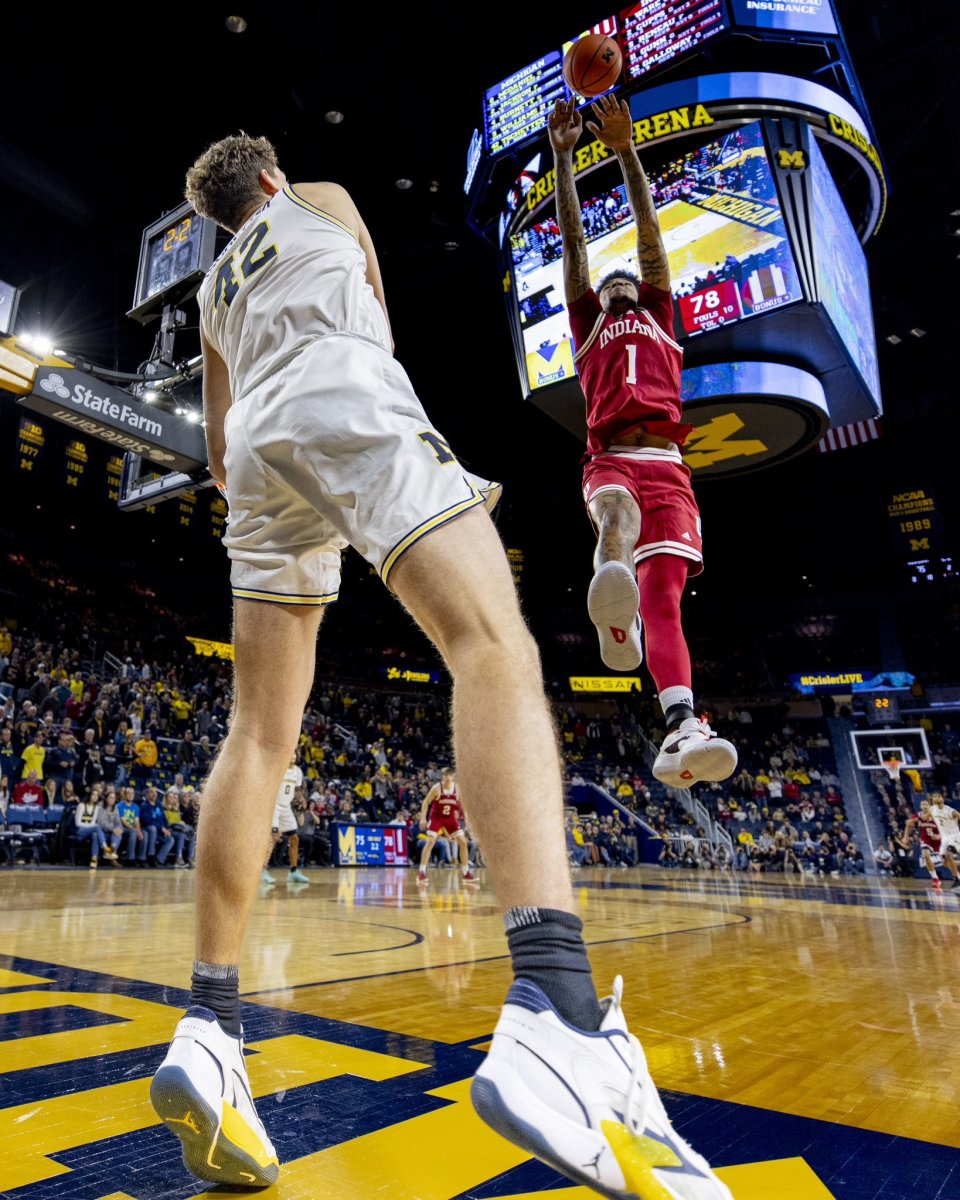
Ware’s value to the Hoosiers is clear when he’s on the court, and it is even more noticeable when he’s absent. Ware was in a walking boot during Indiana’s first game against Wisconsin in Madison, and without their rim protector, the Hoosiers’ defense gave up 91 points. Indiana hung with a top-15 Illinois team in Champaign a week later, and an upset certainly would have been more likely with Ware, a mismatch on both ends for the small-ball Illini.
In the heart of Big Ten play, Ware established himself as one of the conference’s top centers — arguably the most talented and impactful, aside from Edey. You wouldn’t know that by his emotions or the way he carries himself. Ware has “Humble Beast” tattooed across his right shoulder, the one he uses to swat shots three rows into the bleachers or slam highlight-reel dunks. It’s a perfect summation of a player whose introverted personality clashes with his rare skill.
Ware usually lets Assembly Hall make the noise, but he joined the chorus of screams this time.
Indiana clung to a two-point lead with less than 30 seconds left in its game against Iowa on Jan. 30. After a missed three, Trey Galloway came up with a loose ball near the right block and passed it to a wide-open Ware under the basket.
Ware ferociously slammed it home, then let all his emotions out, something the 7-footer hadn’t shown all year. The dunk gave Indiana just enough breathing room to secure a 74-68 win over the Hawkeyes, and it capped off one of the best games of Ware’s young, promising career. Battling through bumps and bruises, Ware finished with 23 points, 10 rebounds and three blocks, while hitting his lone 3-point attempt and making 8-of-10 attempts overall.
That night, no one could question Ware’s drive. It was far from his first standout performance in an Indiana uniform, but highlighted a different side of his game.
“We've kind of coached him into playing better, playing with a little more energy,” Woodson said after the Iowa win. “And I thought tonight, he actually showed some emotion. Hadn't seen that pretty much all year with him, but it was kind of nice to see.”
“He's obviously super talented, super skilled,” Indiana freshman guard Gabe Cupps said. “And a lot of people's knock on him is that he's not tough. And I think he shows it in spurts, but once he can be consistent in that – and he showed that tonight – he's an unstoppable player.”

Ware was unstoppable Feb. 27 against Wisconsin, and Badgers coach Greg Gard called him the best player on the floor. The dominance started with Ware’s bread and butter inside, using polished footwork and strength to score over Wisconsin’s fellow 7-footer Steven Crowl on traditional back-to-the-basket postups. He scored with pick-and-roll dunks and layups in tandem with Trey Galloway and even took his defenders off the bounce with drives from the 3-point line to the basket.
Ware had 13 points, five rebounds and three blocks within the first 13 minutes of the game, but he was far from done, another sign that his motor has reached another level. In less than a minute of play, he had one of the most impressive sequences of his season. He stretched out and drilled a 3-pointer from the top of the key, altered a Wisconsin shot, grabbed the rebound, then calmly knocked down a face-up 15-foot jump shot.
Ware extended Indiana’s lead to 15 points, and Gard called a timeout, hoping Ware’s hot hand would cool off.
"Kel'el Ware had an All-American-type night. 20 points in the first half and he was terrific," Gard said. "But we also gave him easy buckets early where he got some confidence going, and he's a really good player. But he just did whatever he wanted in the first half, specifically."
In a 74-70 win over the Badgers, Ware finished with 27 points, 11 rebounds and five blocks, while making 11-of-12 shots from the field and all four free throws.
“It was unbelievable. He had a man's game. He really did,” Woodson said. “You know, maybe we didn't go to him enough, but he was fantastic tonight. We needed every bit of it in order to win this game.”
“This win means a lot, it’s not even just about me,” Ware said after Indiana snapped its four-game losing streak. “The whole team has just been, as y’all have seen, on a little downhill, but I feel like tonight we finally got over that hump.”
How did he get it done on both ends that night?
“You've just got to play hard,” Ware answered with a laugh, aware of his past critics. “You've just got to play hard.”
Best game of the season for Kel'el Ware in Indiana's win over Wisconsin. 27 points (11/12 FG), 11 rebounds, 5 blocks for the 19-year-old projected first-round pick, who is playing his best basketball as of late. pic.twitter.com/RlGlo4Uz5X
— Jonathan Givony (@DraftExpress) February 28, 2024
Ware said his increased comfort level at Indiana compared to Oregon stems from more playing time — his minutes have doubled from 15.8 to 31.9 — and being given the freedom to play through mistakes, within reason.
“It’s great playing for coach Woodson. Especially, I feel he has the trust in me to go out there and play basketball the way that I play basketball and be able to help the team in whatever way I can.”
At the end of the regular season, Ware is averaging a team-high 16.1 points, 9.8 rebounds and 1.9 blocks per game, while shooting 59.9% from the floor, 44.7% on 38 3-point attempts and 62.7% at the free throw line.
Among Big Ten players on a per game basis, that puts him 10th in points, second in field goal percentage, second in rebounds and tied for fourth in blocks. He might not be on the first team, but that should be enough for an All-Big Ten nod.
“When we brought him on board we didn't know what we were going to get,” Woodson said after the Wisconsin win. “Really didn't. We knew he was very skilled, and the word was that he didn't work hard. I thought after the first month of us getting after him a little bit that kind of picked up and it was a nice carryover into the season.
"He and Malik [Reneau] and Mack [Mgbako] have had really wonderful seasons for us, for guys who really haven't played a lot in college basketball. It says a lot for my staff and the work these guys have put in, along with myself, to get these guys playing at a high level.”
A pro prospect
Ware has a decision to make: stay in college for his junior season, or turn pro. He’s generally considered a late-first or early-second round pick, slotted 19th in NBA.com’s most recent 2024 mock draft and 36th overall on No Ceilings’ latest big board.
Corey Tulaba, an NBA Draft analyst for No Ceilings, has scouted Ware in-person for several games this season and broken down plenty of additional film. Attending Indiana’s games against Rutgers and Louisville, Tulaba said Ware’s length was even more noticeable in person. Some players are listed an inch or two taller on rosters, but Tulaba thought Ware looked a legit, “absolutely massive” 7-feet tall.
His rim-rolling ability on offense and rim protection on defense stood out, as Tulaba thought the Rutgers guards were too intimidated to drive at Ware — stats that don’t show up in a box score as a blocked shot but have similar value.
When Ware was discussed as an NBA prospect last season, the knock on him was that he didn’t play hard consistently. Tulaba said Ware’s motor will still be somewhat of a concern for NBA teams because he had that label for a few years before Indiana. But watching him live this season, Tulaba said he never questioned Ware’s effort.
“He’s not pounding his chest where he’s letting you know that he’s playing hard, but I also think that when you watch him, you’re not like, ‘Oh, man, he took another play off. Didn’t go try to contest that shot at the rim because he didn’t want to put the extra effort in,’” Tulaba said. “I think he’s done a much better job of kind of hushing the critics on that front this year. I think having a guy like Mike Woodson, who has NBA ties, he’ll be able to talk to people in the league and be like, ‘No, no, no. That’s not what we saw out of him,’ and I think that will hold weight too.”
In terms of physicality concerns, Tulaba said most franchises don’t expect rookies to be 100% physically polished and they’ll be patient with him in that respect, knowing he could benefit from continued focus in the weight room. Ware has shown he has the length to be a major shot blocker, and adding more lower-body and core strength will help him not get pushed around.
Tulaba believes the 2024 draft class is less-talented than last year’s, so teams could feel much more comfortable taking a chance on a 7-footer who can score inside and out and block shots. There’s also a heightened sense of confidence in drafting Ware after seeing him play 31.9 minutes per game and producing big numbers at Indiana, compared to taking a risk on his potential in last year’s draft after a season at Oregon in which his college coach didn’t feel comfortable playing him.
All things considered, Tulaba would bet Ware leaves Indiana for the NBA after this season. He anticipates Ware getting a first-round promise and projection after the NBA Draft Combine, and if that’s the case, he should go pro. The idea that he could return to Indiana and prove himself has already been done this year, so Tulaba questions the value of a third year of college.
“I think if he stayed in college for another year — I never fault a prospect for it, I think that some prospects get better doing that and they do it in a way that they can play through mistakes and get heavy minutes — but I think for him, specifically,” Tulaba said. “I don’t necessarily know if it’s going to help him in the same way it might another prospect.”
Ware would become the third NBA draft pick under Woodson, joining Jalen Hood-Schifino and Trayce Jackson-Davis, who were both taken in the 2023 draft. After winning Big Ten Freshman of the Year, the one-and-done Hood-Schifino became the 17th overall pick by the Los Angeles Lakers. Jackson-Davis withdrew from the draft to return to Indiana for his senior season and ultimately became a consensus All-American under Woodson. He was drafted 57th overall by the Washington Wizards and traded to the Golden State Warriors on draft night.
When it comes to Ware’s role in the NBA, Tulaba envisions it being similar to Dereck Lively II and Daniel Gafford, two centers on the Dallas Mavericks. Lively is Ware’s age and was ranked No. 3 in the high school class of 2022, compared to Ware at No. 7. The 7-foot-1 Lively had an underwhelming freshman season at Duke, averaging 5.2 points, but he has started 42 games for the Mavericks, averaging 8.6 points, 7.0 rebounds and 1.4 blocks.
Like Lively, Ware’s role in the NBA, in Tulaba’s opinion, would be simple: set a screen, roll to the hoop, catch an alley oop, alter shots and rebound. With time, Ware’s 3-point shooting could help teams space the floor. If that goes well, along with learning the differences of pick-and-roll defense in the NBA compared to college, Tulaba said Ware’s top-tier outcome is being a player like Brook Lopez, a two-time NBA All-Defensive player who averaged 20 points in his prime.
Ware and the Hoosiers concluded the regular season Sunday with a 65-64 win against Michigan State, an 18-13 overall record, a 10-10 run in Big Ten play and a four-game win streak. They’ll still likely need a Big Ten Tournament title run to reach the NCAA Tournament. And while the season hasn’t resulted in as many wins as Woodson hoped, the player Ware has become in March is not the one people criticized in past seasons, or even the first few weeks at Indiana.
“After that first month, he's been a totally different player,” Woodson said Sunday after beating Michigan State. “I got to give tribute to my coaching staff and how they worked, and we pushed him as a unit and his teammates believe in him. I believe in him. He's been phenomenal. He’s been playing unbelievable.”
Ware always had high potential, but he has turned that potential into production for the Hoosiers. Like Rice forecasted in high school, Ware is on the verge of changing his life and his family’s for generations.
Has he proven his doubters wrong?
“There’s always still more to prove,” Ware said Sunday. “I don’t feel like I’ve proven myself just yet.”
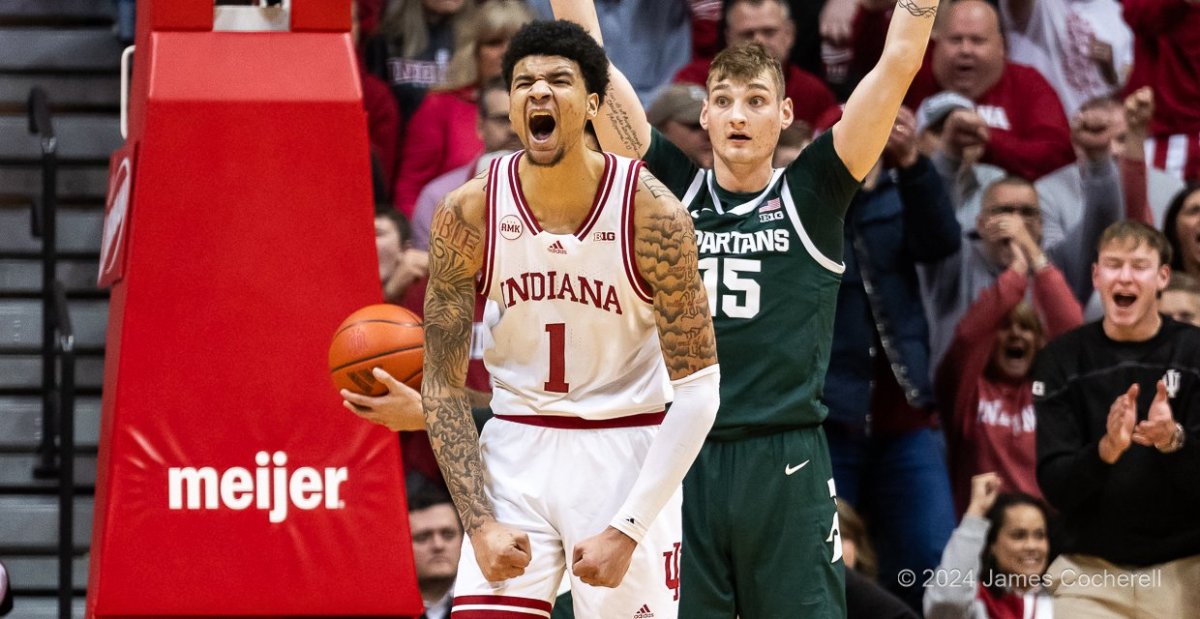
Related stories on Indiana basketball
- INDIANA-MICHIGAN STATE GAME STORY: Kel'el Ware had 28 points and 12 rebounds and made a free throw with 17 seconds to go after missing five straight, helping Indiana beat Michigan State 65-64 in the final regular season game of the year. It was the Hoosiers' fourth straight win. CLICK HERE
- TREY GALLOWAY SENIOR DAY SPEECH: Indiana guard Trey Galloway used his Senior Day speech following the Hoosiers' 65-64 win over Michigan State to announce he's returning for his fifth season in 2024-25. CLICK HERE
- ANTHONY LEAL SENIOR DAY SPEECH: Indiana guard and Bloomington native Anthony Leal announced he'll return for his fifth year in 2024-25 during his Senior Day speech on Sunday after the Hoosiers' 65-64 win over Michigan State. CLICK HERE
- XAVIER JOHNSON SENIOR DAY SPEECH: Indiana is 4-0 since Xavier Johnson returned from an elbow injury, including Sunday's 65-64 win over Michigan State on Johnson's Senior Day. Here's the full video of his speech. CLICK HERE
- ANTHONY WALKER SENIOR DAY SPEECH: Here's the video of Anthony Walker's Senior Day speech following the Hoosiers' 65-64 win over Michigan State. CLICK HERE
